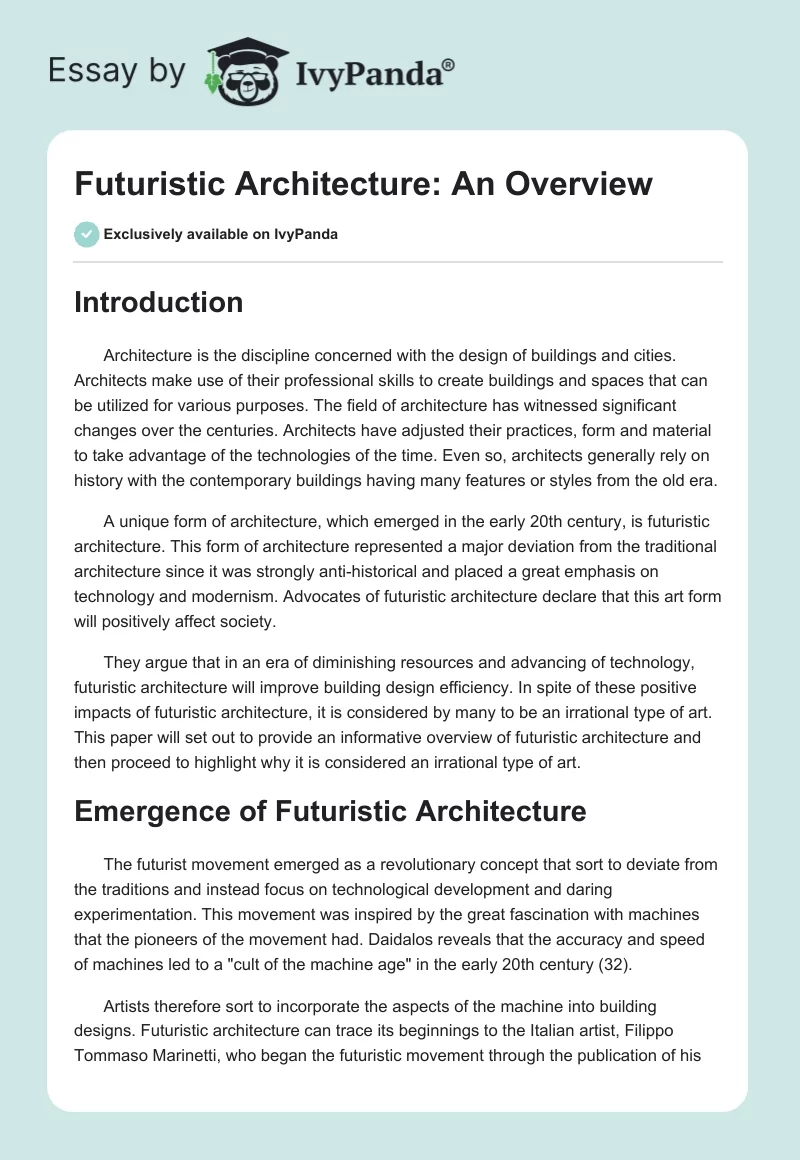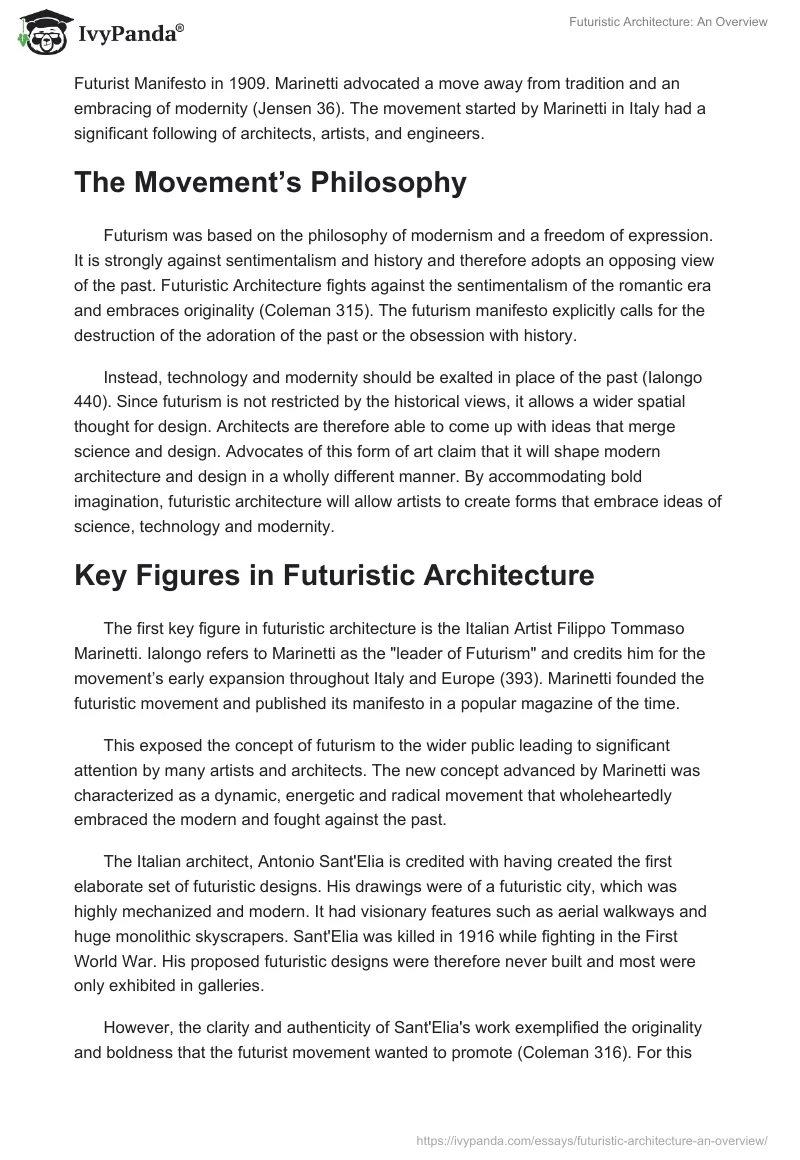Introduction
Architecture is the discipline concerned with the design of buildings and cities. Architects make use of their professional skills to create buildings and spaces that can be utilized for various purposes. The field of architecture has witnessed significant changes over the centuries. Architects have adjusted their practices, form and material to take advantage of the technologies of the time. Even so, architects generally rely on history with the contemporary buildings having many features or styles from the old era.
A unique form of architecture, which emerged in the early 20th century, is futuristic architecture. This form of architecture represented a major deviation from the traditional architecture since it was strongly anti-historical and placed a great emphasis on technology and modernism. Advocates of futuristic architecture declare that this art form will positively affect society.
They argue that in an era of diminishing resources and advancing of technology, futuristic architecture will improve building design efficiency. In spite of these positive impacts of futuristic architecture, it is considered by many to be an irrational type of art. This paper will set out to provide an informative overview of futuristic architecture and then proceed to highlight why it is considered an irrational type of art.
Emergence of Futuristic Architecture
The futurist movement emerged as a revolutionary concept that sort to deviate from the traditions and instead focus on technological development and daring experimentation. This movement was inspired by the great fascination with machines that the pioneers of the movement had. Daidalos reveals that the accuracy and speed of machines led to a “cult of the machine age” in the early 20th century (32).
Artists therefore sort to incorporate the aspects of the machine into building designs. Futuristic architecture can trace its beginnings to the Italian artist, Filippo Tommaso Marinetti, who began the futuristic movement through the publication of his Futurist Manifesto in 1909. Marinetti advocated a move away from tradition and an embracing of modernity (Jensen 36). The movement started by Marinetti in Italy had a significant following of architects, artists, and engineers.
The Movement’s Philosophy
Futurism was based on the philosophy of modernism and a freedom of expression. It is strongly against sentimentalism and history and therefore adopts an opposing view of the past. Futuristic Architecture fights against the sentimentalism of the romantic era and embraces originality (Coleman 315). The futurism manifesto explicitly calls for the destruction of the adoration of the past or the obsession with history.
Instead, technology and modernity should be exalted in place of the past (Ialongo 440). Since futurism is not restricted by the historical views, it allows a wider spatial thought for design. Architects are therefore able to come up with ideas that merge science and design. Advocates of this form of art claim that it will shape modern architecture and design in a wholly different manner. By accommodating bold imagination, futuristic architecture will allow artists to create forms that embrace ideas of science, technology and modernity.
Key Figures in Futuristic Architecture
The first key figure in futuristic architecture is the Italian Artist Filippo Tommaso Marinetti. Ialongo refers to Marinetti as the “leader of Futurism” and credits him for the movement’s early expansion throughout Italy and Europe (393). Marinetti founded the futuristic movement and published its manifesto in a popular magazine of the time.
This exposed the concept of futurism to the wider public leading to significant attention by many artists and architects. The new concept advanced by Marinetti was characterized as a dynamic, energetic and radical movement that wholeheartedly embraced the modern and fought against the past.
The Italian architect, Antonio Sant’Elia is credited with having created the first elaborate set of futuristic designs. His drawings were of a futuristic city, which was highly mechanized and modern. It had visionary features such as aerial walkways and huge monolithic skyscrapers. Sant’Elia was killed in 1916 while fighting in the First World War. His proposed futuristic designs were therefore never built and most were only exhibited in galleries.
However, the clarity and authenticity of Sant’Elia’s work exemplified the originality and boldness that the futurist movement wanted to promote (Coleman 316). For this reason, Sant’Elia’s work became a source of great inspiration for futurists. Architects all over Europe held his drawings in high regard and futurists consider his work the earliest example of futuristic architecture.
The Italian architect Angiolo Mazzoni made significant contributions to futuristic architecture. After joining the futurist movement in 1933, Mazzoni designed a number of original and futuristic buildings in Italy (Jensen 40).
One of the most notable works by Mazzoni is the “heating plant and main controls cabin at Santa Maria Novella railway station”. For its time, this technical facilities building was a masterpiece and ahead of its time. Mazzoni’s design was functional, complex, and highly efficient. It exemplified the ideals of futurism and therefore inspired futuristic designers for decades.
Evolution of Futuristic Architecture
Technology plays a central role in futuristic architecture. Leuth declares that “technology as the vehicle of Utopia will supply the building blocks for the futuristic structures” (319). It can therefore be expected that futuristic architecture should change with changes as technological advances are made. Futurism began with the machine age where the futurists exalted the machine and its inherent attributes such as speed and sleekness.
Since its beginning in 1909, Futuristic architecture has undergone some significant evolutions. The first major evolution was after the Second World War. In this period, the world was introduced to the atomic bomb and before long, the Space Race between the US and the USSR was in progress. Futuristic architecture was therefore inspired by these two technologies. The designs made by architects who subscribed to futuristic concept in this era were greatly influenced by space and the atomic bomb (Leuth 320).
The post WWII era was followed by the post-modern futurism era, which started from the 1960s. Prominent futuristic architects such as Yona Friedmans and Arata Isozaki created impressive designs that were utopian. Arata Isozaki created the design for a space city in 1960 while Yona Friedman proposed a spatial city above Paris in 1963 (Daidalos 33).
Over the decades, futuristic architecture evolved to focus on using innovative technology to create structures that were efficient and modern. Present day futuristic designs address issues such as climate change and resource limitation. They often accomplish this by proposing mega-structures that are built with sustainability in mind.
Why Futuristic Architecture is an Irrational Type of Art
Futurism seeks to replace human art form with non-human products. Cottom elaborates that for futurists, all nuances of the past such as sentimental love, museums, and libraries must be abolished and replaced with machines (87). The founder of futurism, Tommaso Marinetti, contends that the goal of this concept is “to create ‘non-human’ poetry, as well as other arts foreign to humanity, by way of transformations that would follow from the mechanization of humans” (Cottom 87).
Due to the rejection of history, futuristic architecture tries to create designs in an entirely different manner. For the futuristic architect, originality and detachment from the past is desirable (Coleman 344). In an attempt to fulfill this core component of futurism, architects create fresh designs that tend to be obscure or and lacking in aesthetic value. Rational art relies heavily on historical forms and human emotions. Artists are encouraged to study historical material and use this as inspiration for their own works.
Most of the futuristic proposals by architects are based on technologies that do not exist. There are therefore more of a fantasy since the technology that would be needed to implement them might never be developed. Bradley admits that most artists make architectural proposals that can be viewed as science fiction due to their fantastical elements (45).
To support their fantastical visions of futuristic houses and super cities, some artists point out that while internal combustion engines and coal-powered factories were not present 250 years ago, the two are not family technologies that have transformed the world (Bradley 45).
It is therefore plausible that humankind will develop the sweeping technological changes that will make the fantastical visions by today’s artists realizable. While technological progress is assured, it is not possible for architects to accurately predict the path that this progress will take. Creating a design that is based on technology that might never be developed is irrational.
Futuristic architecture is not always able to transform the futurist visions presented by artists into bold urban forms. As noted, futurism requires architects to come up with bold and revolutionary designs. These designs are functional in nature and often have a modern aesthetic appeal.
However, in most cases the forms proposed are novel and exciting but impossible to implement (Coleman 344). The bold and often provocative ideas presented by futuristic architecture only exist as hypothetical designs. As such, while they do offer inspiring visions of a glamorous future, the designs cannot be realized at the present time.
A significant shortcoming of futuristic architecture is that it is too general in nature. Futurists present a vague idea of the forms that architects should create. Futurism provides broad terms such as emphasis of technology, reinforcement of original behavior, and destruction of sentimentalism and history (Bradley 46). However, no specific means of achieving these lofty ideals are provided. Without the availability of a clear means for achieving futurism, architects are often unable to create the dynamic and energetic art forms.
Conclusion
This paper set out to provide an overview of futuristic architecture and discuss by it is an irrational form or art. It began by acknowledging the significance of architecture and how this discipline has changed with technological progress by humans. It then traced the beginning of futuristic architecture in Italy under Filippo Tommaso Marinetti. The paper has shown that futurism seeks to transform futurist visions into bold urban forms that are characterized by great imagination and a deviation from the past.
A review of the most influential futuristic artists has been given and their contributions illustrated. The paper has then elaborated on why futuristic architecture is an irrational type of art. It has shown that while some futuristic designs are based on existing technologies, most of the novel designs are based on technology that is yet to be developed making them fantastical.
Futuristic architecture plays a role by giving architects the chance to present their utopian visions. However, these visions are hardly ever realized and they only remain to be inspirations for other architects and designers.
Works Cited
Bradley, John. “The Urban Remodeler.” Popular Science 277.1 (2010): 45-47. Web.
Coleman, Nathaniel. “Utopic Pedagogies: Alternatives to Degenerate Architecture.” Utopian Studies 23.2 (2012): 314-354. Web.
Cottom, Daniel. “Futurism, Nietzsche, and the Misanthropy of Art.” Common Knowledge 13.1 (2007): 87-97. Web.
Daidalos, Bosman. “Form Follows Function.” Berlin Architectural Journal 74.1 (2000): 30-37. Web.
Ialongo, Ernest. “Filippo Tommaso Marinetti: the Futurist as Fascist, 1929-1937.” Journal of Modern Italian Studies 18.4 (2013): 393-41. Web.
Jensen, Richard. “Futurism and Fascism.” History Today 45.11 (2000): 35-42. Web.
Leuth, Gabriele. Architecture in the Twentieth Century. Vienna: Taschen, 2001. Print.


